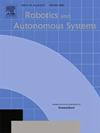A system for docking robotic wheelchair to partially visible table of unknown pose using human input and robotic wheelchair motion
IF 5.2
2区 计算机科学
Q1 AUTOMATION & CONTROL SYSTEMS
引用次数: 0
Abstract
Existing autonomous table docking approaches require large part of table to be visible in order to compute good docking pose for a table with unknown pose. However, in real world settings like cluttered offices and food courts, users often need to initiate docking when the table is only partially visible. This work focuses on the development of a table docking system that enables a wheelchair user to dock to a table with unknown pose, even when the table is partially visible by using human input and the wheelchair motion. An intuitive point-and-click interface is implemented to allow user to initiate docking, by simply clicking on table in the RGB image of the scene. Docking pose is calculated by extracting table edge from the point cloud using the information provided by the user’s click and the streaming RGBD camera images of the scene as the wheelchair moves towards the table. Based on our experiments, accurate table docking can be achieved even when the table is only 20% visible using our approach while the baseline system requires at least 70% of the table to be visible. This makes our system applicable in realistic scenarios. During evaluation with human subjects, all the participants preferred our system over the baseline due to ease of use. Quantitatively, our system more than halved the effort required to initiate autonomous docking as compared to the baseline.
一种利用人的输入和机器人轮椅运动将机器人轮椅对接到部分可见的未知姿态的桌子的系统
现有的自主表对接方法要求表的大部分都是可见的,以便对姿态未知的表计算良好的对接姿态。然而,在现实世界的环境中,比如杂乱的办公室和美食广场,用户通常需要在桌子只有部分可见的情况下启动对接。这项工作的重点是开发一种桌子对接系统,使轮椅使用者能够以未知的姿势停靠在桌子上,即使桌子通过人工输入和轮椅运动部分可见。实现了直观的指向和单击界面,允许用户通过简单地单击场景的RGB图像中的表来启动对接。通过使用用户点击提供的信息和轮椅向桌子移动时现场的流RGBD相机图像,从点云中提取桌子边缘来计算对接姿态。根据我们的实验,使用我们的方法,即使表只有20%可见,也可以实现精确的表对接,而基线系统需要至少70%的表可见。这使得我们的系统适用于现实场景。在与人类受试者进行评估时,由于易于使用,所有参与者都更喜欢我们的系统。从数量上讲,与基线相比,我们的系统启动自主对接所需的工作量减少了一半以上。
本文章由计算机程序翻译,如有差异,请以英文原文为准。
求助全文
约1分钟内获得全文
求助全文
来源期刊

Robotics and Autonomous Systems
工程技术-机器人学
CiteScore
9.00
自引率
7.00%
发文量
164
审稿时长
4.5 months
期刊介绍:
Robotics and Autonomous Systems will carry articles describing fundamental developments in the field of robotics, with special emphasis on autonomous systems. An important goal of this journal is to extend the state of the art in both symbolic and sensory based robot control and learning in the context of autonomous systems.
Robotics and Autonomous Systems will carry articles on the theoretical, computational and experimental aspects of autonomous systems, or modules of such systems.
 求助内容:
求助内容: 应助结果提醒方式:
应助结果提醒方式:


